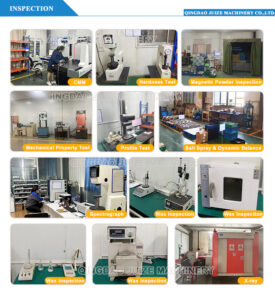
Here’s a detailed explanation of Tensile Testing for Metal Fittings:
Tensile Testing of Metal Fittings: Purpose and Process
Tensile testing is a fundamental mechanical test performed on metal fittings (e.g., brackets, fasteners, connectors, couplings, eye bolts, flanges, structural joints) to evaluate their strength and ductility under uniaxial tensile loading. The primary goal is to determine how a fitting behaves when pulled apart until it fails.
Key Objectives:
Ultimate Tensile Strength (UTS): Determine the maximum stress the fitting can withstand before fracture.
Yield Strength (YS): Measure the stress at which the material transitions from elastic deformation (returns to original shape) to plastic deformation (permanent shape change). Often critical for design limits.
Elongation: Measure the percentage increase in gauge length at fracture, indicating ductility.
Reduction in Area (RA): Measure the percentage decrease in cross-sectional area at the fracture point, another key ductility indicator.
Modulus of Elasticity (Young’s Modulus): Determine the stiffness of the material in its elastic region (slope of the stress-strain curve).
Verification of Material & Process: Ensure the fitting material meets specifications and that manufacturing processes (casting, forging, machining, heat treatment) haven’t introduced defects or weaknesses.
Quality Control & Certification: Provide data for quality assurance and material certification, often required by industry standards or customer contracts.
Testing Equipment & Setup:
Universal Testing Machine (UTM): Also called a Tensile Tester. A hydraulic or servo-electric machine capable of applying a controlled, increasing tensile force.
Load Cell: Precisely measures the applied force.
Grips & Fixtures: Crucial for fittings. Specialized grips (e.g., wedge grips, threaded adapters, clevis pins, custom jigs) are used to securely hold the fitting’s specific geometry without inducing premature failure at the grip points or altering the stress distribution unrealistically.
Extensometer: A device attached directly to the fitting (if a suitable parallel section exists) or the testing fixtures to accurately measure small deformations (strain) within the elastic region and pinpoint the yield point. Video or laser extensometers are used for complex shapes.
Control & Data Acquisition System: Software controls the test (e.g., constant displacement rate) and records force, displacement, strain, and time data to generate a stress-strain curve.
Standard Test Procedure:
Specimen Preparation: The fitting itself is typically tested “as-manufactured” or machined to a standardized test coupon if geometry allows (e.g., ASTM E8 round specimen machined from a representative section of the fitting). Dimensions and critical locations (e.g., thread root, weld zone, bend radius) are carefully measured.
Mounting: The fitting is securely mounted in the appropriate grips/fixtures within the UTM. Alignment is critical to avoid bending stresses.
Extensometer Attachment (if applicable): Attached to the region of interest.
Test Execution: A controlled, constant rate of displacement is applied, stretching the fitting.
Data Collection: Force and displacement/strain data are continuously recorded.
Observation: The test is monitored for yield point behavior, uniform elongation, necking (localized deformation), and fracture mode/location.
Fracture: The test continues until the fitting fractures.
Post-Test Measurement: Final gauge length and fracture area are measured to calculate elongation and reduction of area.
Critical Considerations for Fittings:
Geometry: Complex shapes require specialized fixturing to apply pure tension and avoid bending/shear.
Stress Concentration: Features like threads, holes, sharp corners, welds, or bends are inherent stress raisers. Failure often initiates here. The test evaluates the fitting’s overall performance including these features.
Gripping: Must not crush threads or cause premature failure at the grip. Adapters are common.
Representative Testing: Testing the actual fitting configuration is often more valuable than testing a machined coupon, as it reflects the real-world product integrity.
Standards: Common standards include:
ASTM E8/E8M: Standard Test Methods for Tension Testing of Metallic Materials (often for coupons).
ASTM F606: Standard Test Methods for Determining the Mechanical Properties of Externally and Internally Threaded Fasteners, Washers, Direct Tension Indicators, and Rivets.
ISO 6892-1: Metallic materials — Tensile testing — Part 1: Method of test at room temperature.
Industry-Specific Standards: (e.g., ASME, SAE, API, MIL-SPEC) often reference or adapt these core standards for specific fitting types.
Results & Applications:
Stress-Strain Curve: The primary output, graphically showing material behavior.
Test Report: Includes calculated values (UTS, YS, Elongation %, RA%, Modulus) and observations (fracture location, failure mode).
Design Validation: Engineers use the data to ensure fittings can safely handle expected loads with appropriate safety margins.
Material Selection: Compares different alloys or treatments.
Process Control: Monitors consistency in manufacturing (e.g., heat treatment effectiveness).
Failure Analysis: Helps diagnose reasons for in-service failures.
In essence, tensile testing metal fittings provides critical quantitative data on their load-bearing capacity, deformation characteristics, and overall structural integrity under tension, ensuring they perform reliably and safely in their intended applications.





